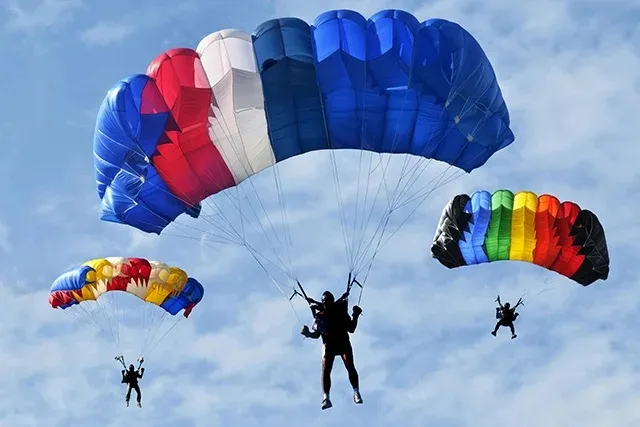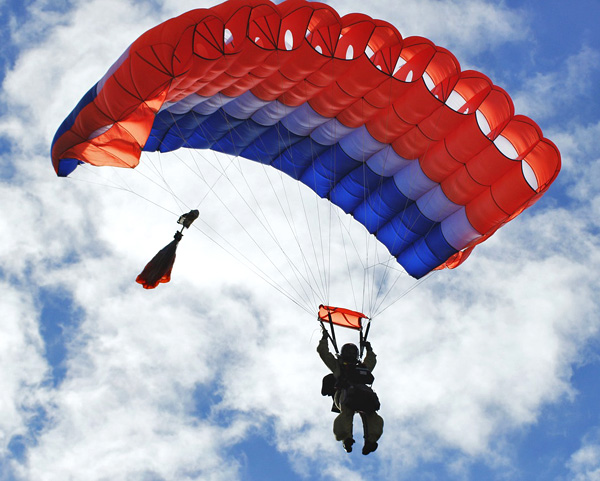Parachutes: The Unsung Heroes of the Sky...!!!
Parachutes have come a long way since their inception, proving to be indispensable for various activities and industries. Their ability to facilitate controlled and safe descents from high altitudes has saved countless lives and enabled exhilarating recreational experiences.

Introduction
A parachute is a marvel of engineering that decelerates an object's descent through the atmosphere by generating drag or lift. These devices are essential for safely bringing people and items down from high altitudes and are integral to activities ranging from recreational skydiving to military missions and space explorations.
Historical Background
The idea of parachutes can be traced back to the Renaissance, with Leonardo da Vinci sketching a prototype in the late 15th century. The successful implementation of parachutes occurred in the late 18th century, with French aeronaut André-Jacques Garnerin executing the first recorded parachute descent in 1797, utilizing a silk canopy.
Design and Mechanics
Parachutes exist in various designs, with the most prevalent being round, cruciform, and ram-air canopies. Their design is crucial for functionality, encompassing elements like the canopy, suspension lines, risers, and harness.
-
Canopy: This is the fabric component that traps air, usually made from lightweight, durable materials like nylon. The canopy's shape and dimensions influence its aerodynamic properties and drag production.
-
Suspension Lines: These cords link the canopy to the harness, evenly distributing the parachutist's weight across the canopy for a stable descent.
-
Risers: Straps that connect the suspension lines to the harness, enabling the parachutist to control the canopy's direction and speed.
-
Harness: Worn by the parachutist, the harness attaches to the risers, offering a secure and comfortable connection to the parachute system.

Types of Parachutes
There are several parachute types, each tailored for specific purposes:
-
Round Parachutes: Traditional parachutes with a circular canopy, often used for military and cargo drops due to their stability and load-handling capacity.
-
Cruciform Parachutes: Featuring a cross-shaped canopy, these provide a more stable descent and reduce oscillation risks.
-
Ram-Air Parachutes: Modern parachutes with a rectangular, wing-like canopy that inflates with air to create lift. They offer superior maneuverability and are popular for skydiving and sport parachuting.
-
Reserve Parachutes: Backup parachutes deployed if the primary parachute fails, typically smaller and packed separately.
Applications
Parachutes serve numerous purposes:
-
Skydiving: A popular recreational use where skydivers jump from aircraft, freefall, and then deploy their parachutes for a controlled descent.
-
Military: Used for airdrops, troop deployment, and special operations. Paratroopers rely on them to land safely in combat zones or behind enemy lines.
-
Emergency Egress: Pilots and astronauts use parachutes for emergency exits from aircraft and spacecraft. Ejection seats in fighter jets come equipped with parachutes for safe descent.
-
Cargo Drops: Delivering supplies and equipment to remote or hard-to-reach areas. Humanitarian missions often use parachute drops to distribute food, medicine, and other essentials.
-
Space Missions: Crucial in space missions for safely returning spacecraft and their occupants to Earth, as seen in the Apollo missions.
Safety and Training
Safe parachute use demands thorough training and adherence to safety protocols. Skydivers and military personnel undergo rigorous instruction on parachute deployment techniques, emergency procedures, and landing strategies. Regular inspections and maintenance of parachute equipment are vital for reliability and performance.
Parachutes have come a long way since their inception, proving to be indispensable for various activities and industries. Their ability to facilitate controlled and safe descents from high altitudes has saved countless lives and enabled exhilarating recreational experiences. As technology advances, parachutes will continue to improve in design, materials, and applications, cementing their status as a pivotal invention in human history.
What's Your Reaction?

















